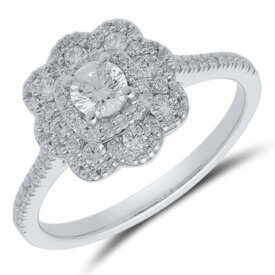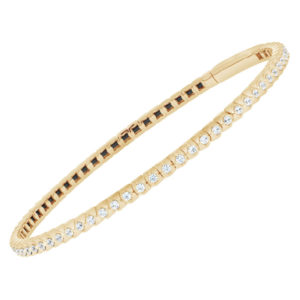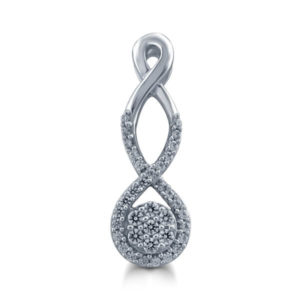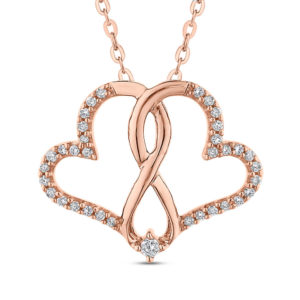Diamond Insights For 2019
The most notable trends in diamond bridal and fashion jewelry are simple, personal and customizable. Consumers today want jewelry they can live in, that is adaptable, easy to layer, and says something about them.
While the diamond sector must continue to meet the needs of Baby Boomer and Gen X consumers, it also must commit to understanding Millennial and Gen Z consumers, and adapt its marketing to incorporate their needs. Bigger than the previous two generations, they will soon have the highest spending power and represent more than two-thirds of total diamond jewelry demand-value.
 Diamond Bridal — Simple, Personal, Customizable
Diamond Bridal — Simple, Personal, Customizable
Simple elegance and personalization/customization are the two biggest trends in diamond bridal jewelry.
“The trend is shifting back to the diamond having a solo performance, a return to traditional,” says Samuel Sandberg, Chairman of the New York-based A. Jaffe. “Solitaires are distinguishing brides today because everyone has a halo.” He sees demand for halos tapering, underscoring though that the solitaires trending are far from plain, with designs under the profile popular. He adds that the trend for stacking diamond bands lends itself well to dressing up a solitaire and changing the look. Halos are evolving to be more important as design elements (i.e. creating flower petals), than to pump up a diamond center, adds Cynthia Speight, Merchandise Manager for IB Goodman in Newport, Kentucky.
While round brilliant cut remains the most popular center, fancy shapes are on the rise, especially oval, pear and cushion cuts. White gold is still No. 1, but two-tone is coming on strong (white and rose, white and yellow), with yellow gold gaining every season. For men, demand for five-stone diamond rings, up to 2-carats total weight, is strong. Two-tone white and yellow gold is a favorite, and ring designs with industrial/architectural elements, sees Speight.
“Having a ring that’s unique is key,” says Valerie Fletcher, Vice President of Design and Product Development for the NYC-based Original Designs Inc. (ODI). “Our customers lean towards bridal that has a combination of traditional and unexpected styling — like mixing a large center with a fashion look. Think Katy Perry’s engagement ring.”
NYC-based Original Designs Inc. (ODI). “Our customers lean towards bridal that has a combination of traditional and unexpected styling — like mixing a large center with a fashion look. Think Katy Perry’s engagement ring.”
Because most women are part of the engagement ring purchase, the trend for customization has grown, says Neil Shah, principal with Shah Luxury in New York City. “That has been a huge change for the industry.” He believes that catering to that trend provides jewelers with the opportunity to create memorable experiences, new traditions, and loyal customers.
Diamond Fashion — Everyday Elegance
The shift among consumers, especially millennials is for everyday luxury, rather than special occasion statement jewelry. Think contemporary styling with an edge, says Fletcher, like sideways hoops instead of traditional, or black diamonds instead of white. “We need to send the message that diamonds are accessible. Fine jewelry should be an everyday luxury that we treat ourselves to and collect, as we do with designer shoes and bags.”
 She finds that self-purchasing women like pieces that say something about them, with favorite motifs including spiritual, celestial, pets, and nature.
She finds that self-purchasing women like pieces that say something about them, with favorite motifs including spiritual, celestial, pets, and nature.
“It’s not about being ostentatious; flaunting status is out,” says Sandberg, noting that diamond jewelry for self-purchase is more delicate, understated and personalized, like A. Jaffe’s Maps charms and cufflinks with diamond accent.
There is not a clear trend in what’s the hottest diamond style, says Robin Gandhi for Aneri Jewels and Laxmi Diamonds in New York City, which presents opportunity. “For a few years it was ‘dancing diamonds’, but today jewelers are finding their own way. Our company has seen bigger diamond jewelry catching on, like single diamond line bracelets.” He says that the traditional line bracelet is popular in 10K gold and up to 4 carats of diamonds total weight. “It’s not as significant in fashion jewelry, as it is in bridal that it be 14K gold.”
Speight says women want jewelry they can live in, which is why IBG’s latest flexible diamond wrap ring, band and line bracelet are bestsellers. Like your favorite jeans with stretch they adjust to the wearer.
Meeting Market Needs
Now is the time for jewelers, particularly independent retailers to be competitive with service, experience, and  special/unique offerings, advocates Sandberg. “Be a destination for diamond engagement and wedding rings and things.”
special/unique offerings, advocates Sandberg. “Be a destination for diamond engagement and wedding rings and things.”
But jewelers must also promote diamonds beyond bridal to succeed in the changing market. Diamond Insights emphasizes that the love opportunity has many facets, and focusing on romantic and familial love will secure the health of about half of retailers’ diamond jewelry sales. Gandhi reports noticeable growth in non-bridal diamond jewelry sales the past two years, particularly for diamond earrings, pendants and bracelets.
Consumers, especially the younger generations, do not want to be told what they should want, says Shah. “They want to personalize pieces and be involved in the design process in some way.” The trend for customization is fortified in their quest to mark their individuality.
 Raised on the advancements in technology and the choices afforded by them, Millennials are open-minded to lab-grown diamonds. Lab-grown diamonds provide choice, not a replacement for mined diamonds, says Cora-Lee Colaizzi, Director of Marketing and Catalogs and Senior Merchandiser for Quality Gold. The Fairfield, Ohio-based manufacturer launched last year its own lab-grown diamond jewelry brand, True Origin, among its bestsellers at JCK Las Vegas.
Raised on the advancements in technology and the choices afforded by them, Millennials are open-minded to lab-grown diamonds. Lab-grown diamonds provide choice, not a replacement for mined diamonds, says Cora-Lee Colaizzi, Director of Marketing and Catalogs and Senior Merchandiser for Quality Gold. The Fairfield, Ohio-based manufacturer launched last year its own lab-grown diamond jewelry brand, True Origin, among its bestsellers at JCK Las Vegas.
Gandhi encourages jewelers to reach out to Millennials where they are and in the ways the want to be connected with. Engage more with Millennials in the community. Create a focus group. Invite Millennials in to find out what they like and want. Hire more Millennials and include them in planning discussions. Have a smart presence on Instagram and YouTube.
Diamond Insights advocates jewelers tailor their communications, messages and media to the behavior and preferences of the younger generations. “Jewelers must invest in digital to provide an omni-channel experience that mixes online and offline interaction,” says Gandhi, “and share how their brand makes a difference in the world.” FYI, Millennials care about social causes, responsible consumerism, fair trade, sustainability, and promoting diversity and inclusion.
Leave a Reply
You must be logged in to post a comment.